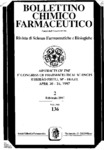Please use this identifier to cite or link to this item:
http://www.alice.cnptia.embrapa.br/alice/handle/doc/12895| Title: | Multiresidue method for the analysis of herbicides in surface and groundwater. |
| Authors: | SANTOS, N. A. G.  BONATO, P. S.   DREOSSI, S. A. C.   GOMES, M. A. F.   CERDEIRA, A. L.   CARVALHO, D.   LANCHOTE, V. L.   |
| Affiliation: | USP; USP; USP; MARCO ANTONIO FERREIRA GOMES, CNPMA; ANTONIO LUIZ CERDEIRA, CNPMA; USP; USP. |
| Date Issued: | 1997 |
| Citation: | In: CONGRESS OF PHARMACEUTICAL SCIENCES, 1., 1997, Ribeirao Preto, SP. Bolletino Chimico Farmaceutico, v.136, p.133, 1997. Abstract. |
| Description: | The high standards for drinking water purity laid down by the European Community, United States and other coutries require the development of suitable analytical methods with high sensitivity, selectivity, accuracy and reliability, that permit the analysis of a broad variety of substances in a single run, or at least those substances that are important in a specific water catchment area. The standard method for the investigation of environmental pollutants has been gas chromatography using different selective detectors after extraction with different organic solvents. Some of that substances that are difficult to analyze by gas chromatography because of thermal instability or chemical polarity, may be analyzed by high performance liquid chromatography. In the present study we employed this technique to develop a highly sensitive method for the simultaneous analysis of atrazine, simazine, ametryne, tebuthiuron and diuron in surface and groundwater. The aqueous samples (100 ml ) were filtered through 0.22 um membranes to remove suspended matter. After adjusting the pH by the addition of 25 uL of 4M NaOH, the samples were extracted with 12 ml dichloromethane by mechanical shaking for 1 hour. After phase separation, 6 ml of the organic phases were transferred to conic test tubes and the solvent was evaporated to dryness under a stream of nitrogen at 35oC. The residues were dissolved in 200 ul of the mobile phase and 100 ul were chromatographed on a Lichrospher 100 RP-8 column (particle 5 um , 125x4mm, Merck) using 0.05 M phosphate buffer, pH 5.5, and acetonitrile (73:27, v/v) as mobile phase. The triazine herbicides were detected at 220 nm, whereas tebuthiuron and diuron were detected at 254 nm. The recovery obtained in the extration procedure was higher than 95% for all herbicides except simazine for which the recovery was 85.6%. Due to the enrichment in the extraction procedure and the sensitive detection at two wavelengths it was possible to obtain a quantification limit of 0.02 ug/L for all herbicides studied. The method was linear over the range of 0.02 to 2.0 ug/L. The method was employed for the analysis of suface and groundwater samples collected over a period of ten months (10/95 to 07/96) in the Ribeirao Preto region. Our results show that the method was suitable for the sensitive screening of these herbicides. |
| Keywords: | Multiresidue method Surface and groundwater Analysis of herbicides |
| Type of Material: | Artigo de periódico |
| Access: | openAccess |
| Appears in Collections: | Resumo em anais de congresso (CNPMA)  |
Files in This Item:
| File | Description | Size | Format | |
|---|---|---|---|---|
| 1997RAs010.PDF | 87.83 kB | Adobe PDF |  View/Open |









